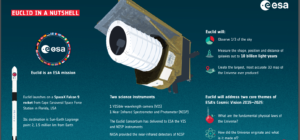ESA’s Euclid on Its Way to Study the “Dark Universe”
ESA’s Euclid spacecraft is on its way to the L2 Lagrange point where it will spend six years collecting data to help scientists understand the nature of dark energy and dark matter — what some call the Dark Universe. Between them, they make up 95 percent of the universe, but scientists do not know any more than that and hope data from Euclid, NASA’s upcoming Roman Space Telescope and ground-based telescopes will provide some answers.
Euclid lifted off from Cape Canaveral, FL on a SpaceX Falcon 9 at 11:12 am EDT, a rare instance in which ESA is using a U.S. rocket.
LIFTOFF of #ESAEuclid from SLC-40 in Florida on 1 July 2023! pic.twitter.com/K0bGBnUfoG
— ESA (@esa) July 1, 2023
ESA typically uses Europe’s own large Ariane and small Vega rockets, or Russia’s medium-class Soyuz. European-Russian agreements on space cooperation largely ended after Russia invaded Ukraine in February 2022, however, and Soyuz no longer is available for ESA’s use. Euclid is too big for Vega. Ariane 5 is being replaced by Ariane 6. The last Ariane 5 will launch next week and Ariane 6 is behind schedule. Rather than waiting for Ariane 6, ESA decided to look elsewhere and found Falcon 9 met the technical requirements and SpaceX could accommodate the schedule.
The launch today was perfect and set Euclid on a trajectory to the Sun-Earth Lagrange Point 2, SEL-2, 1 million miles (1.5 million kilometers) from Earth in the direction away from the Sun. ESA’s Gaia spacecraft and the NASA-ESA-CSA James Webb Space Telescope already are at SEL-2 . Lagrange points are where the gravitational forces of two celestial objects — the Sun and Earth in this case — balance each other out allowing a third — a spacecraft like Euclid, for example — to remain in a fixed relative position with miminal expenditure of fuel.

The €1.4 billion ($1.5 billion) Euclid spacecraft will arrive at SEL-2 in four weeks, followed by two months of commissioning the two instruments: a VISible-wavelength camera (VIS) and a Near-Infrared Spectrometer and Photometer (NISP). The instruments were provided by the Euclid Consortium a group of about 2,500 scientists and engineers from more than 15 countries. NASA provided the near-infrared detectors for NISP. Thales Alenia Space was the prime contractor for the spacecraft.

Once operational, Euclid will observe one-third of the universe out to a distance of 10 billion light years collecting data about the early universe that scientists hope will reveal of the nature of dark matter and dark energy.
Based on previous observations, they conclude that ordinary matter (baryons) that makes up the planets, stars and galaxies we see is not enough to explain the motions within galaxies and clusters. Other matter we can’t see — “dark matter” — must exist.
Similarly, scientists studying the rate at which the universe is expanding and who expected it to be slowing down due to gravitational effects were surprised to discover in 1998 based on data from the Hubble Space Telescope that the rate is accelerating instead. Some other force — some other energy — is pushing it apart: “dark energy.”
They now calculate that the universe is comprised of 5 percent ordinary matter, 27 percent dark matter, and 68 percent dark energy.
In its most recent Decadal Survey on astronomy and astrophysics, the National Academies of Sciences, Engineering and Medicine said the current standard cosmological model, LambdaCDM, “is one of the major intellectual triumphs of the past few years,” but “the nature and origin of its key ingredients—dark matter, dark energy, and a nearly scale-invariant spectrum of primeval mass fluctuations—remain, however, some of the biggest mysteries in science.”
Euclid will make a 3D map of billions of galaxies to show how the universe has expanded and its structure evolved over the past 10 billion years. Scientists will study that data to detect, for example, how light from the galaxies is distorted by gravitational effects from matter — ordinary matter and dark matter — to try and determine the distribution of dark matter.
Euclid is not alone in its quest. NASA’s Nancy Grace Roman Space Telescope, formerly the Wide-Field Infrared Survey Telescope (WFIRST), will join the hunt when it’s launched in 2027. The Roman space telescope is managed at NASA’s Goddard Space Flight Center, which developed this chart showing how Euclid and Roman complement each other.

Euclid will observe a greater swath of the universe, about one-third, in optical and infrared wavelengths back 10 billion years in time to when the universe was 3 billion years old. Roman will observe only in the infrared and one-twentieth of the sky, looking back 2 billion years, but will see much fainter galaxies.
Ground-based telescopes, especially the National Science Foundation/Department of Energy Vera C. Rubin Observatory in Chile, are also searching for answers.
Euclid is named after the ancient Greek mathematician Euclid of Alexandria, who is heralded as the Father of Geometry. ESA says it chose that name because “the density of matter and energy is linked to the geometry of the universe.”
User Comments
SpacePolicyOnline.com has the right (but not the obligation) to monitor the comments and to remove any materials it deems inappropriate. We do not post comments that include links to other websites since we have no control over that content nor can we verify the security of such links.